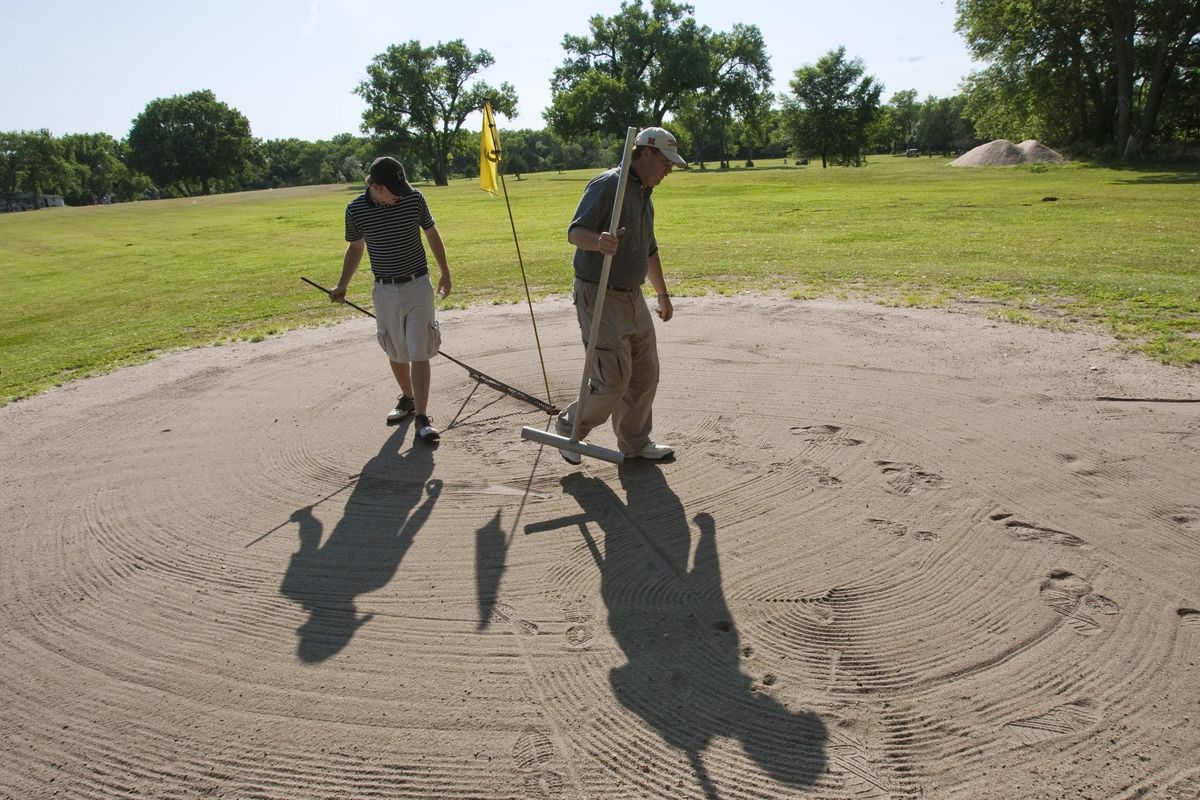Stuck in sand
Handful of courses still using gritty greens

CENTRAL CITY, Neb. – That’s no misprint at the bottom of the Riverside Golf Club scorecard: “Please remember to rake your greens.”
Matt Nicholas, who grew up playing at this nine-hole course nestled alongside the Platte River in central Nebraska, is almost a scratch golfer on sand. He feels a childhood attachment to the place.
“I started playing here when I was 5 years old, started playing league when I was 12,” he said. “I feel like it’s my own little paradise.”
The number of these paradises is dwindling.
Sand-green courses once were common on the wind-swept plains and in other places it was difficult to maintain grass. Pinehurst No. 2 in North Carolina had sand greens until 1935. Improved technology — in sprinkler systems and more durable strains of turf — led many courses to switch to grass greens in the 1950s and ’60s.
No major golf organization tracks the number of sand-green courses left in the United States. Jeff Bollig of the Golf Course Superintendents’ Association of America guessed there might be 150 nationwide, out of nearly 16,000 golf courses total, with about 20 of the sand-green courses in Nebraska.
Three-time U.S. Open champion Hale Irwin grew up playing on sand greens in Kansas. Vijay Singh, who has won three majors, putted on sand as a club pro in Malaysia. Steve Jones, who won the 1996 U.S. Open, knocked it around on the sand in New Mexico as a kid.
But for the most part, sand greens are a rare sight in the U.S.
The game’s the same off the tee, but changes on approach shots and chips.
On the 324-yard second hole, Nicholas drove to the side of the green. His chip splashed onto the sand, bounced once and dropped into the hole for an eagle-2.
“I use two different chipping styles. I use a gap wedge on sand and a lob wedge on grass,” he said. “I can play just a low pitch shot that lands a couple feet in front of the hole. You throw it at the pin, definitely.”
The greens are circular, about 35 feet across with sand 2 or 3 inches deep. Golfers play target golf because when the ball plops onto the green, it usually rolls just a foot or two.
Leaning against a rack behind each green are a metal rake and “drag.” The player whose ball is farthest away will use the “drag” to smooth out a path from the ball to the hole.
His or her playing partners measure the distance of their balls from the hole. They then set their balls on the putting path that same distance from the hole.
Putting starts, with the golfer farthest out going first. The path is re-dragged after each putt.
No greens keepers here — just do-it-yourselfers. After the last golfer putts, one of them pulls the rake in circles behind him or her to smooth the surface for the following group.
Irwin said he would like to see sand greens make a comeback.
“There are a number of places that sand greens might make a resurgence because of our water issues and challenges facing many of today’s golf courses in trying to keep them up,” he said. “Sand greens are unique, but they aren’t impossible to play.”
Sand greens of yesteryear were an environmentalist’s nightmare. To create a faster putting surface and keep the sand from blowing away, motor oil was dumped on the greens once or twice a year.
“Your shoes would be black, the golf ball would have a little residue on it,” said Tim Nicholas, Matt’s father, “but, God, they putted nice.”
Riverside applies biodegradable soybean oil to keep its sand compact. Therein lies a difference between grass and sand greens. On grass, moisture slows down the greens. On sand, moisture speeds them up.
There are other quirks, too.
At another Nebraska course, Dannebrog, the greens are square and have fences around them to keep off cattle. On the second hole, golfers must hit over a giant grain bin to reach the green.
In Pawnee City, golfers must clear a 10-foot hog shed on a par-3 hole. The dings on the tin roof just add to the charm. Golfers unlucky enough to hit the shed must take a drop and a one-stroke penalty. There are no unusual obstacles at Riverside. Sprigs of grass mix with clover and bare spots in the fairways. The rough is indistinguishable.
The course chatter, though, takes some getting used to, especially when golfers shout to a partner, “You’re going to be in the sand.”
To the ear of a grass-greens golfer, that’s bad news.
At Riverside and courses of its kind, it’s good news.
“It is a piece of the past,” said Tim Nicholas. “We’re going to be around for a while. It’s a nice place, and we’re going to keep it going.”